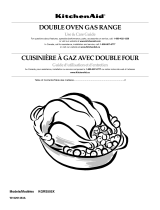
THANK YOU for purchasing this high-quality product. Register your new range at www.whirlpool.com. In Canada, register your range
at www.whirlpool.ca.
For future reference, please make a note of your product model and serial numbers. These can be located on the oven frame behind the
top right side of the oven door.
Model Number__________________________________________ Serial Number__________________________________________
Nous vous REMERCIONS d’avoir acheté ce produit de grande qualité. Enregistrer votre nouvelle cuisinière sur www.whirlpool.com. Au
Canada, enregistrez votre cuisinière au www.whirlpool.ca.
Pour référence future, veuillez prendre en note les numéros de modèle et de série de votre produit. Ceux-ci se trouvent sur le châssis du
four, derrière la partie supérieure droite de la porte du four.
Numéro de modèle__________________________________________ Numéro de série__________________________________________
Table of Contents Table des matières
W11508873A
STANDARD CLEANING GAS RANGE
USE & CARE GUIDE
RANGE SAFETY .............................................................................2
The Anti-Tip Bracket ....................................................................3
COOKTOP USE ..............................................................................4
Cooktop Controls .........................................................................4
Surface Burners ...........................................................................4
Griddle ..........................................................................................5
Home Canning .............................................................................5
Cookware .....................................................................................5
ELECTRONIC OVEN CONTROL ...................................................6
Display ..........................................................................................6
Oven Indicator Lights ...................................................................6
Start ..............................................................................................6
Off/Cancel ....................................................................................6
Clock ............................................................................................6
Tones ............................................................................................6
Fahrenheit and Celsius .................................................................7
Timer ............................................................................................. 7
Control Lock .................................................................................7
Oven Temperature Control ...........................................................7
OVEN USE ....................................................................................... 8
Aluminum Foil ............................................................................... 8
Positioning Racks and Bakeware ................................................8
Bakeware ......................................................................................8
Oven Vent .....................................................................................9
Baking and Roasting ....................................................................9
Broiling..........................................................................................9
RANGE CARE ...............................................................................10
General Cleaning ........................................................................10
Oven Light ..................................................................................11
Oven Door ..................................................................................11
Removing the Oven Bottom ......................................................12
TROUBLESHOOTING ..................................................................12
ASSISTANCE OR SERVICE .........................................................14
In the U.S.A. ...............................................................................14
In Canada ...................................................................................14
Accessories ................................................................................14
SÉCURITÉ DE LA CUISINIÈRE ...................................................15
Bride antibasculement ...............................................................16
UTILISATION DE LA TABLE DE CUISSON ................................17
Commandes de la table de cuisson ..........................................17
Brûleurs de surface ....................................................................17
Plaque à frire ..............................................................................18
Préparation de conserves à la maison ......................................18
Ustensiles de cuisson ................................................................18
COMMANDE ÉLECTRONIQUE DU FOUR .................................19
Afchage ....................................................................................19
Témoins lumineux du four ..........................................................19
Start (mise en marche) ...............................................................19
Off/Cancel (arrêt/annulation) ......................................................19
Clock (horloge) ...........................................................................19
Signaux sonores .........................................................................19
Fahrenheitet Celsius ..................................................................20
Timer (minuterie) .........................................................................20
Control Lock (verrouillagedescommandes) .............................20
Commande de la température du four ......................................20
UTILISATION DU FOUR ...............................................................21
Papier d’aluminium ....................................................................21
Positionnement des grilles et des ustensiles de cuisson
au four .....................................................................................21
Ustensiles de cuisson ................................................................21
Évent du four ..............................................................................21
Cuisson et rôtissage au four ......................................................21
Cuisson au gril ............................................................................21
ENTRETIEN DE LA CUSINIÈRE ..................................................23
Nettoyage général ......................................................................23
Lampe du four ............................................................................24
Porte du four ..............................................................................24
Enlèvement du panneau au fond du four ..................................25
DÉPANNAGE .................................................................................25
ASSISTANCE OU DÉPANNAGE ..................................................26
Aux É.-U. ....................................................................................27
Au Canada ..................................................................................27
Accessoires ................................................................................27
CUISINIÈRE À GAZ À NETTOYAGE STANDARD
GUIDE D’UTILISATION ETD’ENTRETIEN















